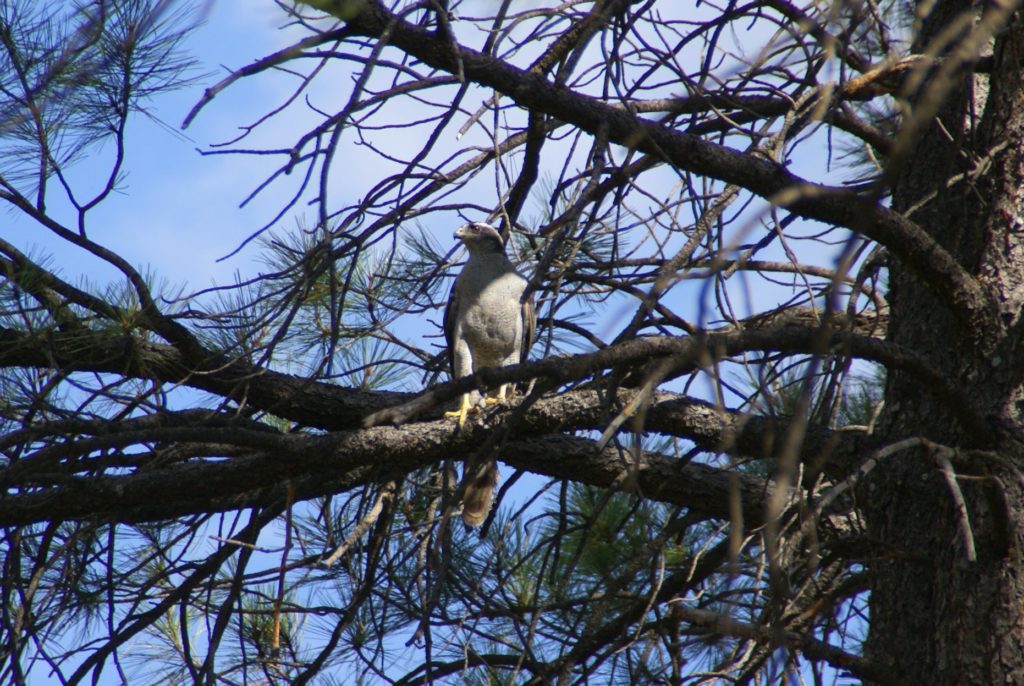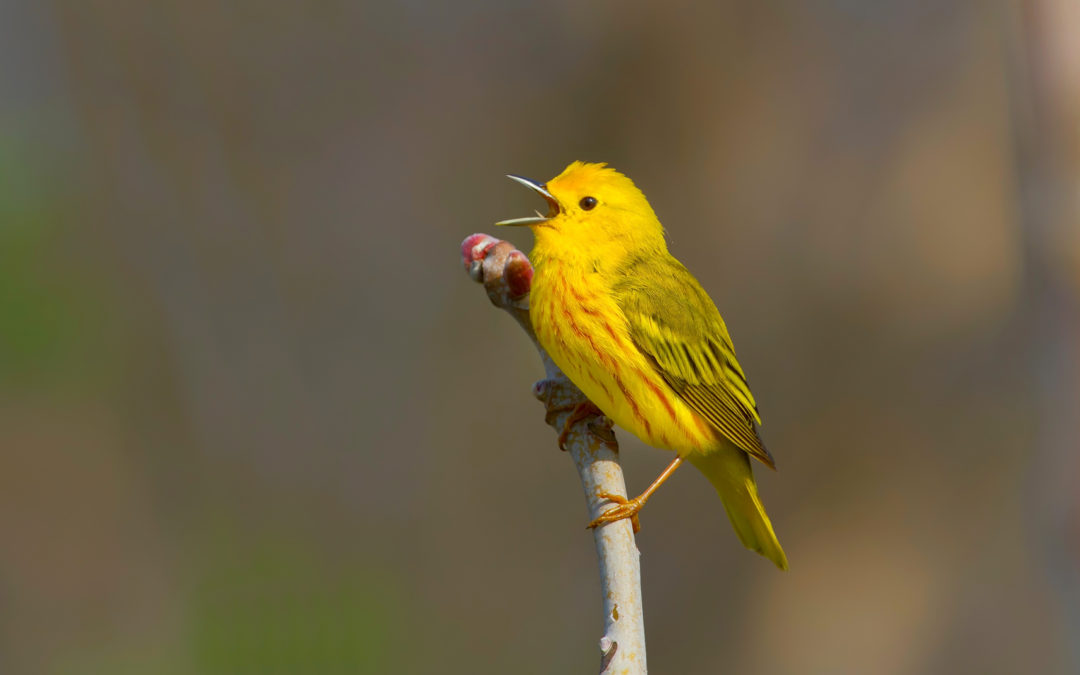
by jhwildlife | Jun 22, 2018 | Blog, Nature Mapping Jackson Hole
by Max Frankenberry, Assistant Bird Bander
Jackson Hole has officially entered the season of sun and snowmelt. Tourists are making their way through town to and from the parks, and the bustle around downtown Jackson has gotten exponentially louder. But step outside of downtown to the National Elk Refuge, a Cache Creek trailhead or even your own backyard, and you notice that human sounds aren’t the only noises that get louder this time of year. Choruses of birds at dawn, trills of surprised ground squirrels in the afternoons and the croaks of frogs in the evening remind us that this is quite the time to be alive in the mountains.

Boreal chorus frog – Gibbon Meadows; Credit: Neal Herbert; May 2014
These symphonies are enjoyable and relaxing to say the least, but they can also be valuable identification tools for Nature Mappers! Learning to ID bird songs, frog calls and even mammal sounds opens your range of observation drastically. Boreal Chorus frogs may be experts at wetland camouflage, and can even avoid our eyes when we’re right on top of them, but learn to recognize their calls and those hidden creatures become as obvious as a moose in the sagebrush. And what better time to start than the summertime! Many species are the most vocal during this time of year, and a walk down your street in the early morning or in the evening can be a great place to begin soaking in those summer sounds.

Wildlife Identification by Ear Resources
Attached below are some excellent resources for learning amphibian and bird songs in particular. Our Nature Mapping database has been especially lacking in amphibian observations, and we know they are out there! Identifying wildlife by ear is a valuable skill, and practice makes perfect. The more practice you put in, the more species you can confidently Nature Map this summer!
Calls of Wyoming’s Frogs and Toads – https://www.wyomingbiodiversity.org/index.php/Initiatives-Programs/CitSci/rocky-mountain-amphibian-project/wyomings-amphibians/amphibian-calls
Bird ID Skills: How to Learn Bird Songs and Calls – https://www.allaboutbirds.org/how-to-learn-bird-songs-and-calls/
Mammals Sound Gallery – http://www.bioacoustica.org/gallery/mammals_eng.html
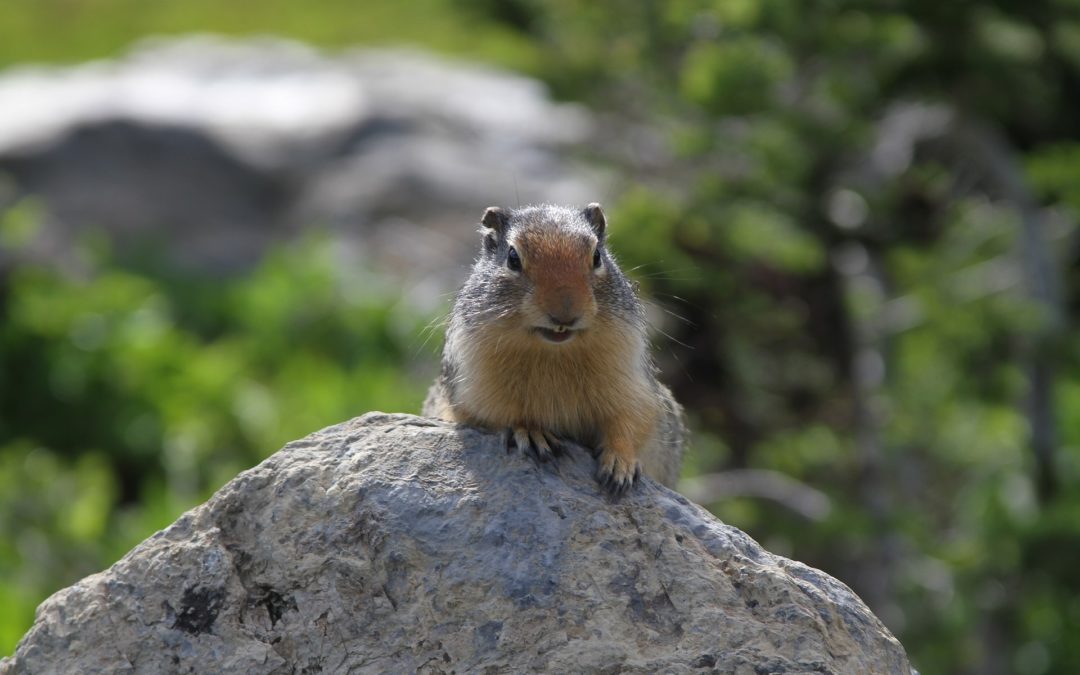
by jhwildlife | Jun 18, 2018 | Blog, Nature Mapping Jackson Hole
by Frances Clark, Lead Ambassador Nature Mapping Jackson Hole
At this time of year, people see their lawn and gardens riddled with ground squirrels or pocket gophers or their trees chewed to toppling by beaver and ask, “What is the purpose of these pests?”
Small mammals serve as prey for our large mammals and raptors and provide other ecological services, such as aeration and recycling of soil and nutrients. Beaver, our largest rodents, form habitat for many other creatures, although they are a nuisance to homeowners with ponds and aspen plantings.
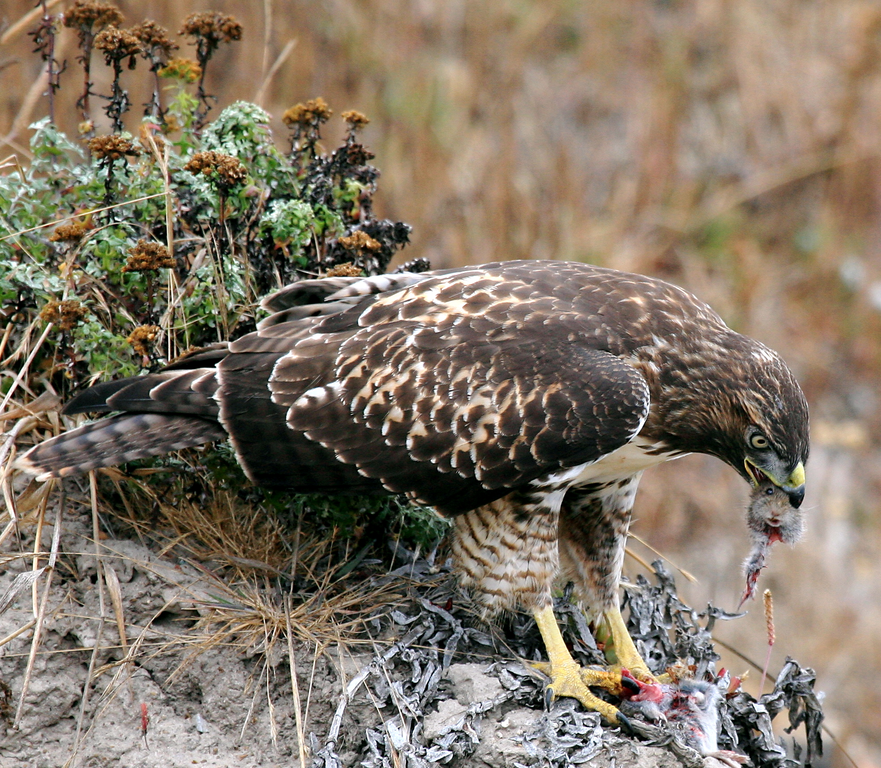
Small mammals serve as prey for raptors and other animals. Photo: Steve Jurvetson
Uinta ground squirrels are common in sage and grassland habitats, and they find similar features in lawns. They dig tunnels and form sleeping chambers, thereby creating holes and mounds, much to the consternation of homeowners and ranchers. I have nature mapped dozens and dozens of ground squirrels driving out the National Elk Refuge road in spring. Indeed they emerge and mate in April and each pair can produce four to seven young by May, which then scamper about every which-way eating grasses and flowers. Their abundance can seem overwhelming, even repulsive.
Driving out this same route a day in mid-June, I spied several red-tailed hawks, Swainson’s hawks and even golden eagles soaring overhead and a coyote or two trotting through the fields, ears alert. The high-pitched alarm calls of ground squirrels came from all directions. I realized the abundance of raptors was due to the plentitude of squirrels. Uinta ground squirrels are tasty packets of protein. They are a necessary and timely food source for raising young raptor chicks, red fox kits and coyote pups. And the time is short… Uinta ground squirrels are above ground only three months before they go dormant in August for the next nine months. Many don’t make it.
Other raptors, including northern harriers, prairie falcons and American kestrels, hunt open areas for rodents in sizes appropriate to their body weight. In addition to Uinta ground squirrels, least chipmunks, meadow voles and deer mice are important components of their diets. In old growth forests, red-backed voles nourish northern goshawks and pine martens. Great horned owls also devour small mammals. Fortunately, most small rodents don’t bother us humans.
Another annoyance in cultivated areas is northern pocket gopher. As snow melts, one can see the extensive “eskers” that mark the pocket gophers’ progress underground eating roots, rhizomes and tubers for food. In summer, occasional fresh mounds of soil indicate areas of activity. Rarely does one see a whiskered grey face, with tiny eyes and ears, emerge from a hole. Bear, fox and coyote use their ears to find this plump fossorial (digging) prey. The Teton Raptor Center is monitoring pocket gophers as part of their population studies of the majestic great gray owl. Great gray owls can hear pocket gophers moving under feet of snow and plunge feet first to catch their vital winter meal.
In addition, pocket gophers are particularly important in enhancing soils in mountain meadows. Their prodigious earth movement churns up nutrients, allows water and air to seep into hard-packed soils and provides opportunities for seed germination.
Young beaver move up creeks and irrigation ditches to find new territory to raise a family. The sound of running water and presence of willows and aspen stimulates dam building. Some of these appealing sites are now landscaped into ponds surrounded by aspen trees. Beaver build dams to impound water to serve as moats and insulation for their lodges, where they raise their young and keep safe. Anyone who has visited Schwabacher’s Landing or Moose-Wilson Road in the park has witnessed the diversity sustained by these industrious rodents. Beaver impoundments encourage willows, sedges and aquatics, which in turn provide food and shelter for ducks, sora, amphibians and moose. The U.S. Forest Service and other groups are moving trapped beavers up drainages to enhance wildlife habitat and also to help with flood control and water quality. While beaver can be pesky in our expanding human habitats, they are much needed in our natural habitats.
Even the most lowly, annoying-to-us critter has a role to play in our ecosystem. While no one wants wildlife in our homes, understanding the importance of each species in Jackson Hole can enhance our enjoyment of the out-of-doors, even in our own backyard.
How to Nature Map Small Mammals:
Nature mappers can help record the use of habitats — both cultivated and wild — by many of our often unseen or unappreciated small mammals. Here are some tips for mapping a few rodents and related species:
Uinta ground squirrels are buffy brown, about a foot long, with short tails. They often sit erect near the entrance to their burrow holes or look like soft lumps of manure on the edge of roads, until they move. We particularly encourage notations on the First of Year (FOY) appearances in March and April and Last of Year (LOY) sightings in late July and early August.
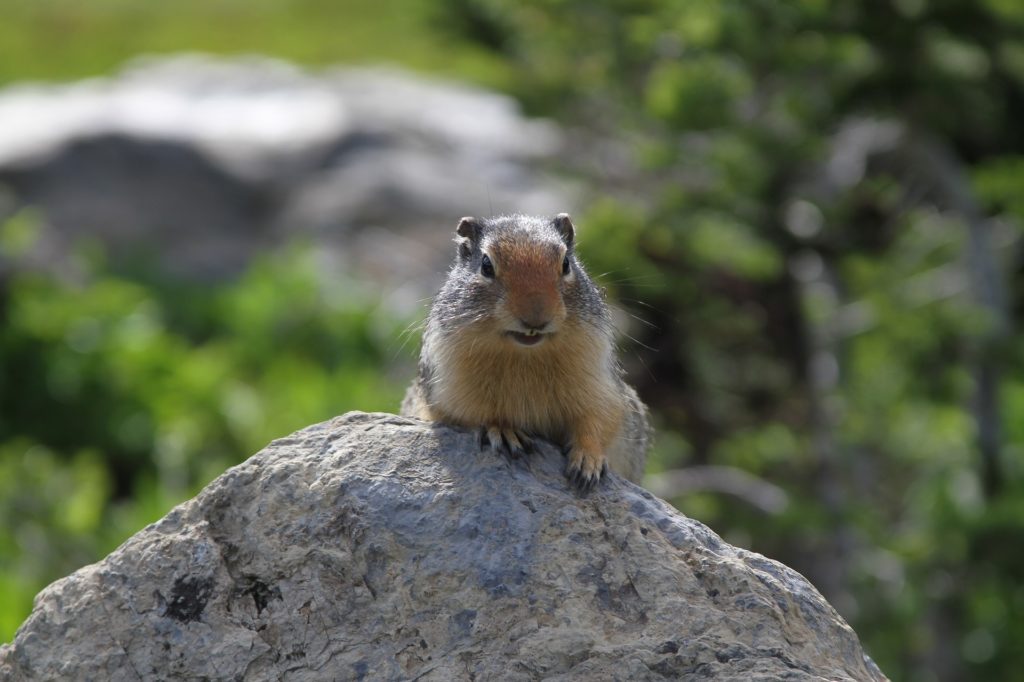
Uinta Ground Squirrel
Our other ground squirrel, Golden-mantled ground squirrel, looks like a chipmunk due to two set of stripes on its back, but unlike chipmunks, it does not have stripes on its head or tail. These are mostly found in forests, rocky areas and some shrubby sites, particularly at higher elevations.
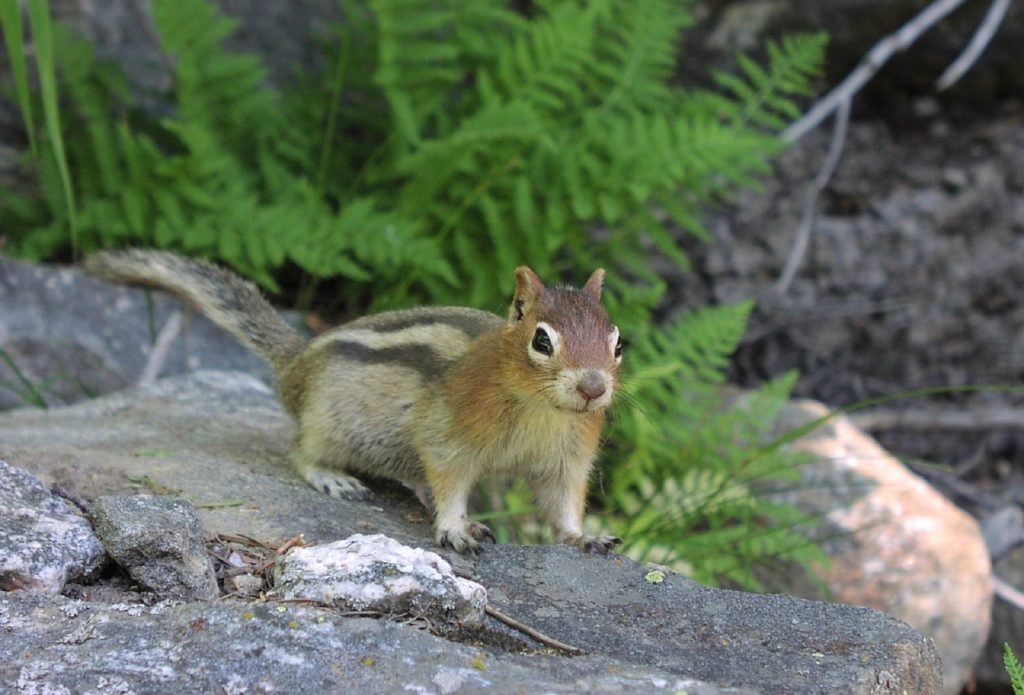
Golden-Mantled Ground Squirrel
We have three species of chipmunks: all have stripes on their heads, backs, and to some extent down their tails. Least chipmunk is more likely in the sage flats and runs with its tail straight up. The tail is longer than its body. It is smaller and darker on its belly than the Uinta chipmunk, which is found more in coniferous forests or shrubby areas. Uinta chipmunk tends to have a lighter belly and a wider tail. Unlike the other two species found in Jackson Hole, Uinta chipmunks have a white outermost stripe along their backs (rather than a fairly distinct black or blackish-brown stripe), which is shown nicely in this Berkeley photo. Relatively more brightly colored, yellow pine chipmunk is also a forest species and has orange highlights. These can be very difficult to distinguish. Do your best, but when in doubt leave it out.

Three Chipmunks in Jackson Hole: Least (left), Uinta (middle) and Yellow Pine (right). Middle and right photos Wyoming Game & Fish Department (WGFD).
Northern pocket gophers by their nature are hard to see unless you are lucky. These gray, 8 inch animals have small eyes, tiny ears, and large front feet with noticeable claws. Their tunnels are obvious either as 3-4 inch rounded eskers left over from winter foraging or fresh mounds of soil about a foot wide and several inches high in summer. This “sign” can be used to indicate areas of abundance in sage flats, meadows or forest openings.
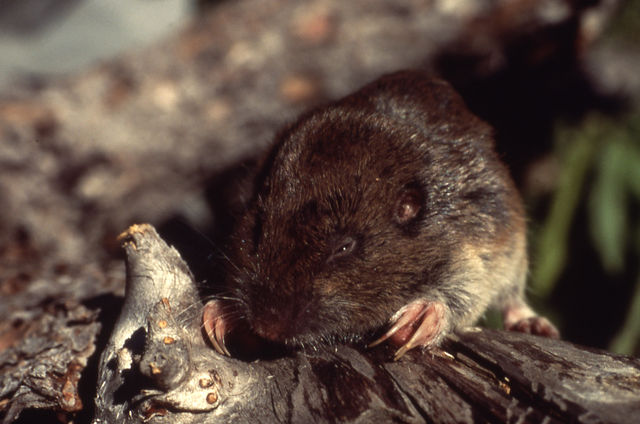
Pocket Gopher, Yellowstone National Park; Gillian Bowser; 1990
Mice, voles, and shrews are impossible to identify to species; therefore, we encourage nature mappers do their best record the groups. Mice have big ears and long tails. Voles have smaller ears and shorter tails and look relatively compact compared to mice. Shrews, which are a separate family, have elongate pointed heads with small eyes and ears and many teeth to eat their prey of insects, earthworms and the like. Tails vary in length. Our common species is masked shrew. We do not have moles in Jackson Hole.

Mouse (left), Vole (middle), and Shrew (right).
Beaver can be distinguished from their relative muskrat by their flat vs. rat-like tails seen while swimming in water. While both have rich brown pelts, beaver are usually bigger with a flatter head and are found among willows or other woody plants, which they use for food and dam building. Muskrats use soft-stemmed cattails, reeds and rushes to form their mounds and for food; therefore, they are more likely in wet meadows and marshes.
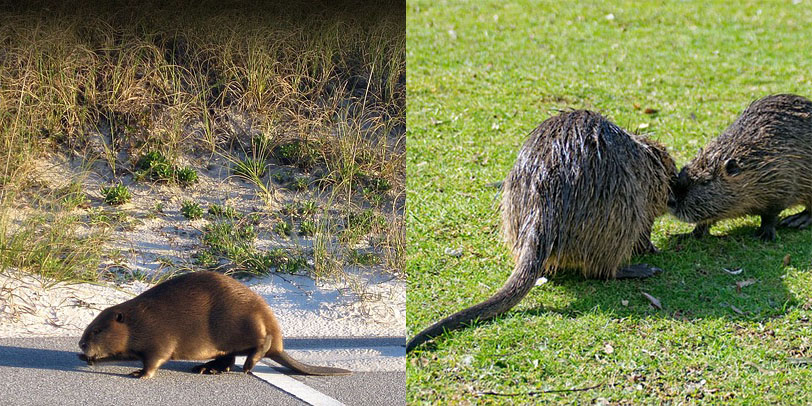
Beaver (left) has a flat tail while its relative, the Muskrat (right), has a rat-like tail.
Red Squirrels: Many people recognize the wide-eyed, bushy-tailed red squirrel found in forests and porches. Often we hear their chatter in the deeper forest. These tree squirrels are defending their territories and particularly their caches of cones. If you happen to see an active “midden,” pile of cone scales and stalks, take a point. This is an indicator of highly productive trees and possible pine marten habitat.
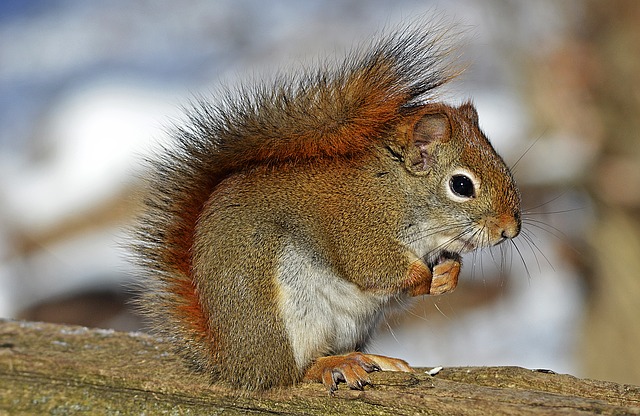
Red squirrel
by jhwildlife | Jun 7, 2018 | Blog
Communications Manager – Job Description
About Jackson Hole Wildlife Foundation
For 25 years, the Jackson Hole Wildlife Foundation (JHWF) has helped our community to live compatibly with wildlife – by working collaboratively with landowners and public land managers to remove or improve fences, by empowering citizen naturalists to build our local knowledge base, and by acting to make roads safer for people and animals. Our grassroots, volunteer-supported model and hands-on approach reflects our belief that enduring conservation emerges from an engaged and committed community. Strategically, we are focused on preserving and improving the migration corridors that sustain wildlife and connect communities.
Summary of Main Responsibilities
The Communications Manager drives JHWF’s internal and external communications. The Communications Manager reports to the Executive Director, is a member of the organization’s management team, and is responsible for providing input that guides JHWF’s strategic actions. The Communications Manager connects JHWF with the public through visual and verbal storytelling, designs informative and creative communications pieces, delivers public presentations, and works to expand and diversify our support base. This position will help to establish and implement communications objectives; develop, edit and share content; and manage JHWF’s social and digital media tools. The right candidate will exhibit strong writing and interpersonal skills and will have the ability to interpret scientific concepts and conservation strategies for a varied audience. Possessing a good eye for visual presentation and design will also be a valuable characteristic demonstrated by the ideal candidate.
The essential functions include, but are not limited to, the following:
Content Creation and Public/Media Outreach
• Develop, curate and distribute content for annual print newsletter, monthly email campaigns, weekly blog, and timely videos.
• Design and prepare marketing collateral, press releases, reports, and presentations.
• Manage and organize digital assets.
• Develop engaging materials and tools to drive support for JHWF programs.
• Compose and emphasize key messages to be shared with staff, board and public.
• Design strategy for JHWF’s presence at external events and represent JHWF as needed.
• Serve as first point of contact at JHWF, via managing main phone and info@jhwildlife.org email account.
• Develop positive relationships with media and respond to media inquiries.
• Work with outside consultants and resources to place op-eds, stories and articles in a variety of publications.
Digital and Social Media
• Develop strategy and regularly publish/update web and social media content to support JHWF’s programs, activities and events.
• Maintain the JHWF’s website and blog.
• Maintain the JHWF’s social media channels; track and evaluate engagement to maximize reach. Utilize paid advertising opportunities as deemed appropriate.
• Monitor and constructively engage in relevant online conversations.
• Advise, train, and support staff on use of digital media tools.
• Ensure communications infrastructure is maintained, including server, website, etc.
Development and Organizational
• Contribute to long-term planning with management team and board to increase impact.
• Support JHWF development efforts by crafting donor and donor prospect communications, informational pieces and fundraising campaigns.
• Process donations, gift entry and bank deposits.
• Manage contacts database (Salesforce).
• Participate in programmatic work and contribute to organizational activities as needed.
Required Qualifications
• Minimum of two years of communications strategy and implementation experience including strong experience with digital media, social media, web design, publishing and partner relationship management tools.
• Bachelor’s degree in related field.
• Familiarity with wildlife conservation, wildlife management, large-landscape scale conservation and citizen science.
• Passionate about conservation, wildlife, volunteerism, connecting people to nature.
• Ability to work independently, set priorities and see projects through to completion.
• Ability to contribute positively within a collaborative team environment.
• Outstanding written and verbal communication skills.
• Flexibility to experiment to attain new, better strategies, approaches, work products and solutions to challenges.
Preferred Qualifications and Experience
• Experience working in a nonprofit or philanthropic organization (conservation/wildlife especially).
• Salesforce, WordPress, Adobe InDesign, Illustrator, and Photoshop experience.
Compensation: salary, including benefits, based upon experience and skills.
Benefits include: Medical, dental, life and short-term disability insurance; paid sick leave, holidays and vacation.
To Apply: Please email a letter of interest and résumé with three references to: Kate@jhwildlife.org. For more information, visit: www.jhwildlife.org.
Application Deadline: June 24.
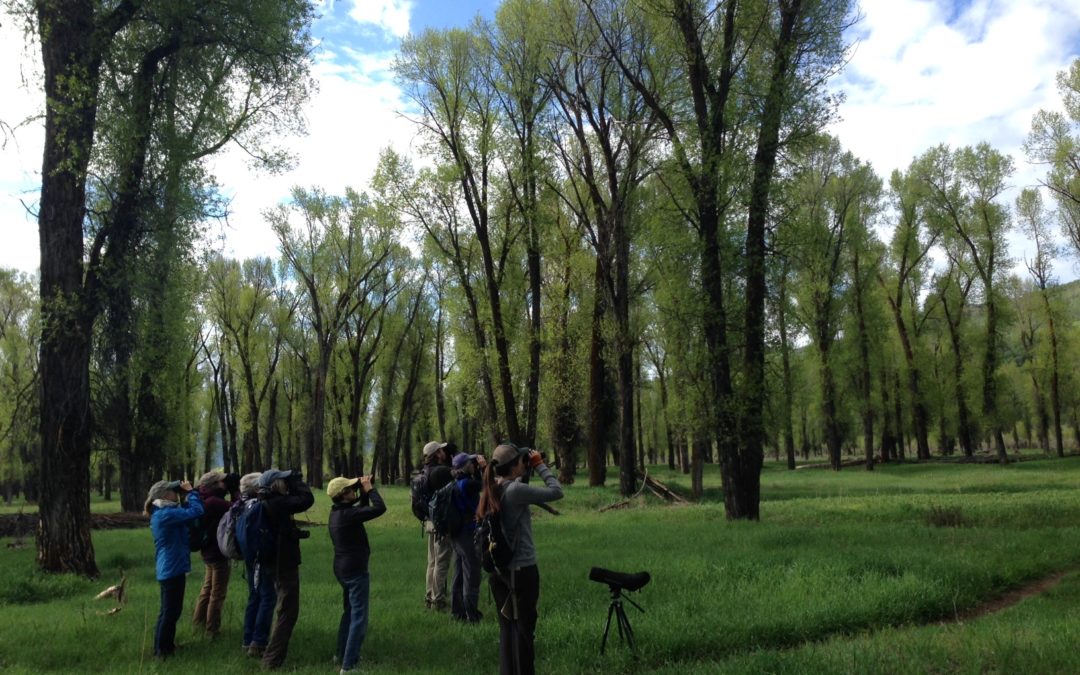
by jhwildlife | May 23, 2018 | Blog, Nature Mapping Jackson Hole
by Max Frankenberry, JHWF Assistant Bird Bander
This past Saturday, May 19, 2018, JHWF staff participated in the annual Wyoming Game & Fish Department bird survey of the South Park Wildlife Habitat Management Area, just south of Jackson. Our group of volunteer birders, including enthusiastic Nature Mappers and Jackson Hole Bird & Nature Club members, met bright and early Saturday morning, led by our local bird nerd expert volunteer, Tim Griffith. Tim has been crucial to organizing Game & Fish bird surveys of the South Park area since 2016, which have so far logged 96 different species for the area! Our pack split into two groups, one to tackle waterfowl, shorebirds and raptors around the ponds, the other to take on “Warbler Alley,” the thick cottonwood tree groves hugging the backwaters of the Snake River to the southeast. What an appropriate nickname that was – Yellow Warblers dotted most every tree in South Park, and were joined by the radiant Yellow-rumped, Wilson’s and MacGillivary’s Warblers as well. It was a different traveler from the south, however, that took everyone by surprise.
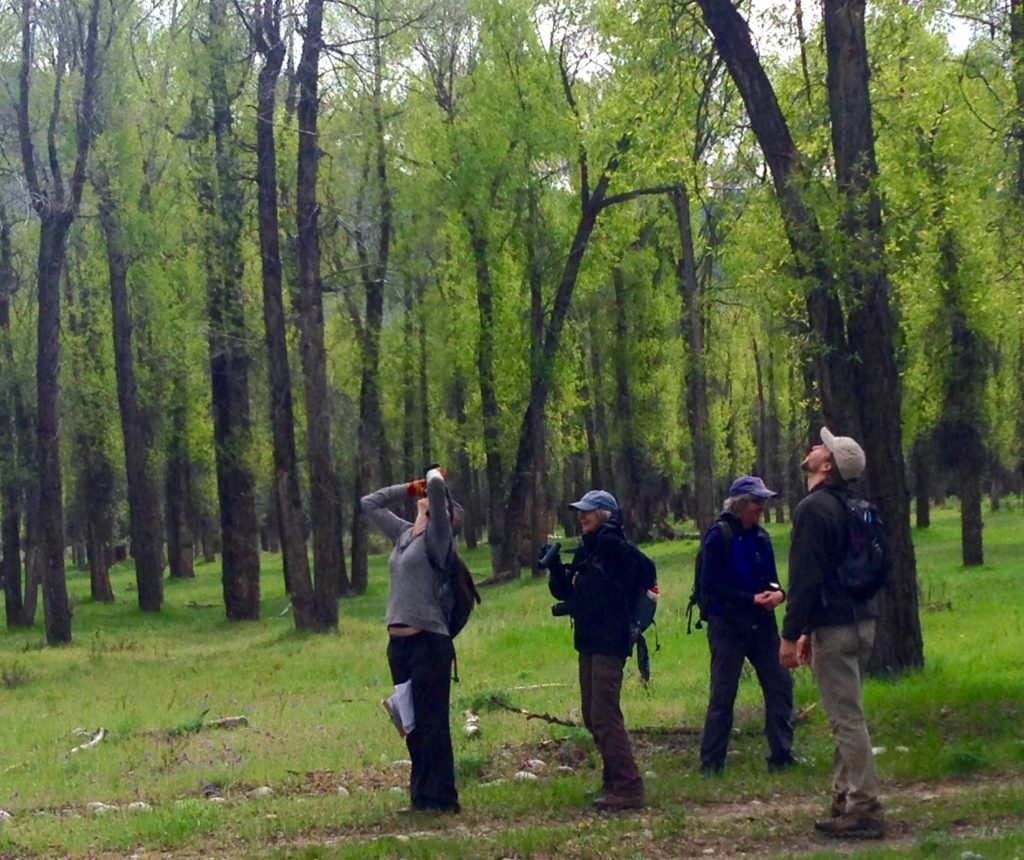
‘Warbler’s neck’ is a common occurrence on a bird survey.
After a busy four hours of hiking and birding the survey was winding down, and brunch was on the brain. But birding tends to deliver the bombshells at the last moments, and Saturday was no different. Jon Mobeck, our team’s oriole-obsessed leader shouted. “Bullock’s! Wait… BALTIMORE!” In a low hawthorn tree not 50 feet from us, was not only a Bullock’s Oriole, a gorgeous but fairly common bird in Jackson Hole, but next to it was a Baltimore Oriole, a normally much more eastern cousin. Historical records vary, but this bird may be one of less than a dozen ever reported in the state of Wyoming, and likely less than a handful have ever been seen in Teton County. What a find! The Bullock’s and Baltimore seemed to follow each other, flying from tree to tree after one another. Perhaps the Baltimore had lost his way on his normal spring route up from Central America, noticed a bird that resembled his brilliant orange color, and followed that Bullock’s back to our western mountains, far away from his normal east-of-the-plains summer vacation.
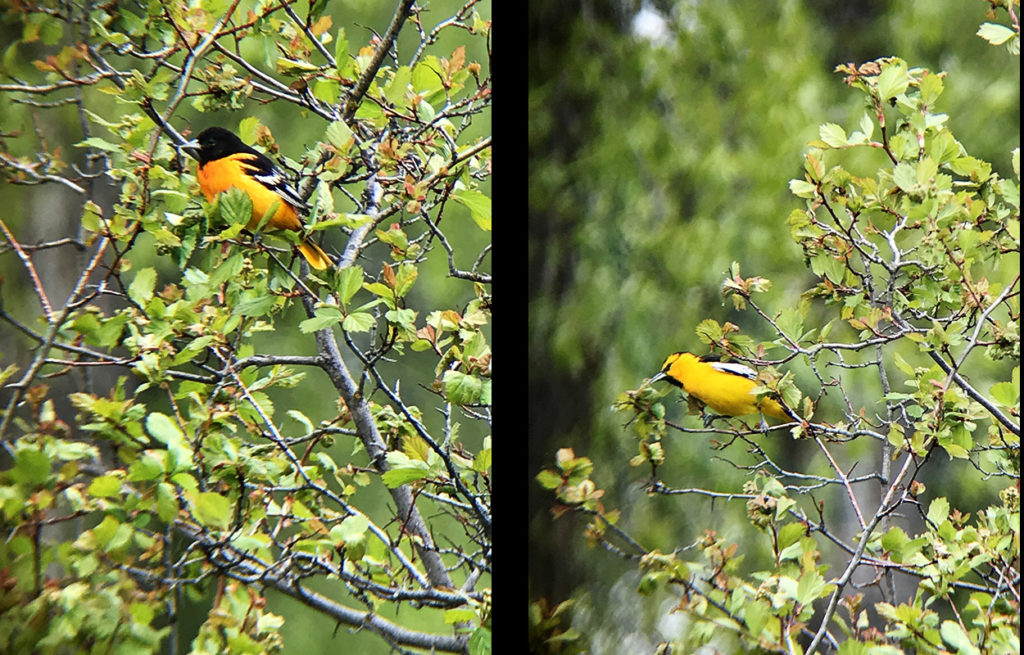
A Baltimore Oriole (left) is a rare find in Jackson Hole. The Bullock’s Oriole (right) is more of a local. Photos: Kate Maley
It’s moments like these that make us realize how special close-to-home wild places like South Park are. The diversity of wildlife in these areas can be astounding. But problems exist in the fact that unless these places are studied or surveyed, we may never know the rarities or struggling populations there. This is the issue Nature Mapping Jackson Hole is helping to solve – by submitting data from your commute from work, a dog-walk in a Jackson city park or a backpacking trip through the Gros Ventre, you are helping to build our human community’s understanding of the wildlife community that surrounds us. And every data point really is significant! You don’t often find rare birds like the Baltimore Oriole, but it’s very possible that the deer you saw driving home could represent the beginning of a muley movement exploring a new feeding ground in Jackson Hole. The data you enter from these sightings help JHWF’s partners to prepare management decisions that inspire positive interaction between humans and the wildlife moving into these areas. Knowing that your effort can directly benefit our local species is a reward in itself, and who knows – maybe your attention to wildlife developed from Nature Mapping will lead you to that once-in-a-lifetime animal.
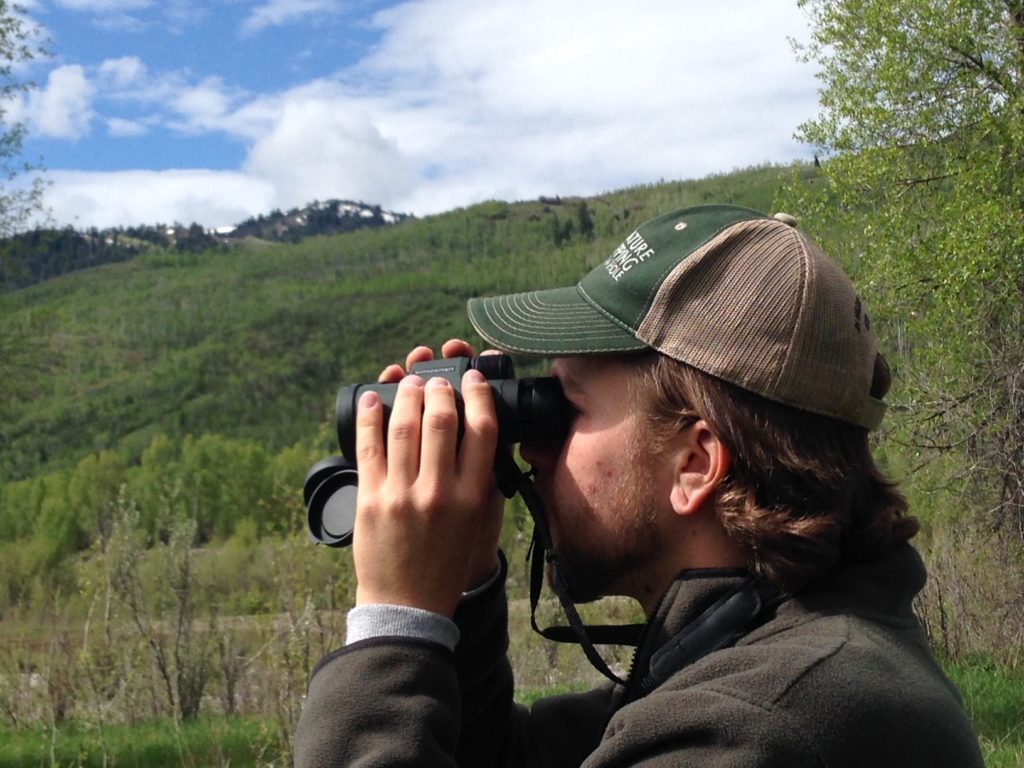
Max Frankenberry spots a Common Merganser on a back channel of the Snake River through Wingspan Optics binoculars.
South Park Wildlife Habitat Management Area Species Count 2018 Surveyed by 22 Participants
American Coot 3
American Crow 1
American Goldfinch 11
American Kestrel 13
American Robin 74
American White Pelican 38
American Wigeon 9
Bald Eagle 6
BALTIMORE ORIOLE 1
Bank Swallow 4
Barn Swallow 6
Barrow’s Goldeneye 16
Belted Kingfisher 4
Black-billed Magpie 9
Black-capped Chickadee 24
Black-headed Grosbeak 2
Blue-winged Teal
Brewer’s Blackbird 1
Broad-tail Hummingbird 2
Brown-headed Cowbird 6
Bufflehead
Bullock’s Oriole 4
Calliope Hummingbird 6
Canada Goose 114
Cedar Waxwing
Chipping Sparrow 2
Cinnamon Teal 47
Cliff Swallow 7
Common Merganser 37
Common Raven 15
Common Yellowthroat
Cooper’s Hawk 1
Dark-eyed Junco
Double-crested Cormorant
Dusky Flycatcher
Eared Grebe
Eastern Kingbird
European Starling 21
Gadwall 84
Gray Catbird 1
Great Blue Heron 6
Green-tailed Towhee 1
Green-winged Teal 2
House Wren 14
Killdeer 12
Lazuli Bunting
Lesser Scaup 7
Lincoln Sparrow
MacGillivary’s Warbler 3
Mallard 52
Marsh Wren 5
Mountain Bluebird
Mountain Chickadee
Mourning Dove
N. Rough Wing Swallow 11
Northern Flicker 19
Northern Shoveler
Orange-crowned Warbler 2
Osprey 6
Pied-billed Grebe
Pine Siskin
Redhead Duck
Red-naped Sapsucker
Red-tailed Hawk 6
Red-winged Blackbird 62
Ring-billed Gull 2
Ring-necked Duck 12
Ruby-crowned Kinglet 7
Ruddy Duck 4
Sandhill Crane 3
Savannah Sparrow 6
Sharp-shinned Hawk
Song Sparrow 51
Sora 3
Spotted Sandpiper 24
Swainson’s Thrush 1
Tree Swallow 219
Trumpeter Swan 2
Turkey Vulture 6
Vesper Sparrow 2
Violet-green Swallow 3
Virginia Rail 1
Western Meadowlark 3
Western Tanager 1
Western Wood Pewee
Western/Clark’s Grebe
White-breasted Nuthatch 1
White-crowned Sparrow 3
White-faced Ibis
Wilson’s Phalarope
Wilson’s Snipe
Wilson’s Warbler 1
Wood Duck
Yellow Warbler 130
Yellow-headed Blackbird 37
Yellow-rumped Warbler 94
Species Total 68
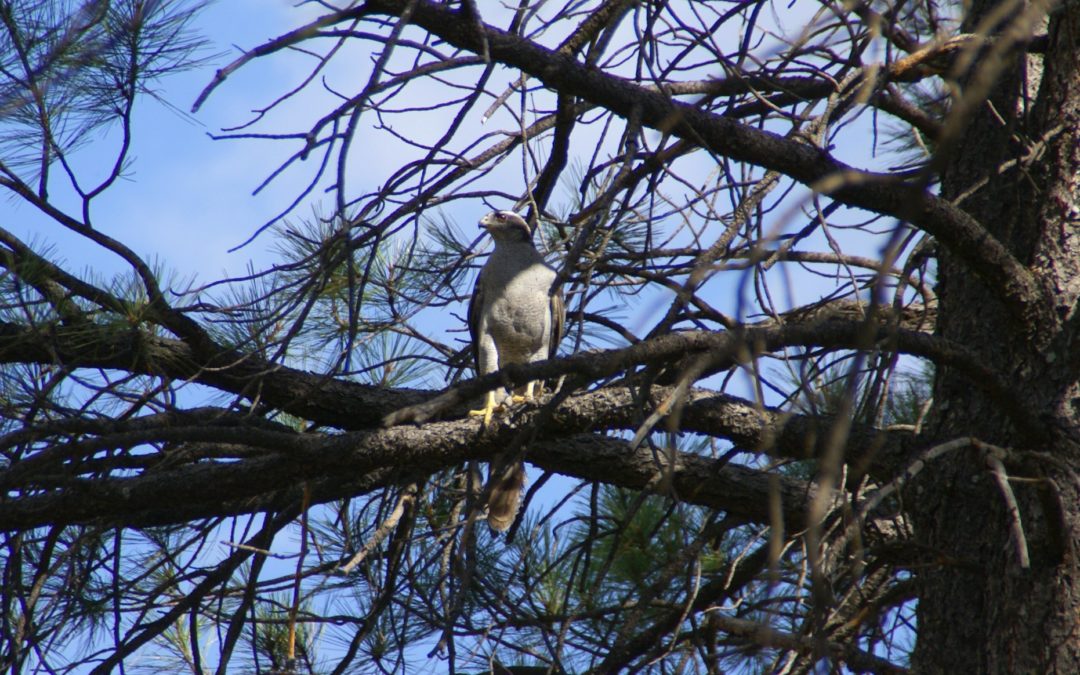
by jhwildlife | May 17, 2018 | Blog
by Jon Mobeck, Executive Director
This is the story of an elusive and magnificent bird, and a story of a walk in the woods. They are connected.
I enjoy wandering in the forest, looking and listening for things. I’m not alone.
One morning recently, I parked at the trailhead, pulled out my phone and tapped the Audubon Birds Pro app. Before I entered this particular mixed forest of aspen and conifer, I wanted to familiarize myself once more with the calls of the bird I hoped to find.
Northern Goshawk (Accipiter gentilis). Family: Hawks and Eagles. Description: 20-26” (51-66 cm). W. 3’ 6” (1.1 m). Adult distinctive if seen well, gray-barred below, with black face, sharp white eyebrow. Voice: Loud kak-kak-kak-kak-kak when disturbed.
One more time. Kak-kak-kak-kak-kak. Listen. OK. Got it.
As I start walking, I don’t want to play the sound anymore since it can be disruptive to birds – and to me, since I want to be present here. But I do replay the goshawk call in my head. That is, until the calls and songs of other birds capture my attention. First I hear an American Robin, and then many, zipping from one aspen branch to the next. A bit farther up the trail I see a Ruffed Grouse strut across the path. Curious how uninterested they seem to be in my presence. Surrounding me are the songs of the Black-capped Chickadee, reminding me of my childhood in the woods of Minnesota. Hearing the song of a chickadee connects time and space for many of us.
Back to the Northern Goshawk. (My mind wanders with the birds!) I leave the trail and start heading uphill into a deep stand of pine. Within a few minutes, I hear it. No mistaking it. I’m going in the right direction! Based on where I think I heard the sound, I’m probably a few hundred yards away. Just over some deadfall and up the hill somewhere. I scramble up with excitement. The Northern Goshawk is not the sort of bird that you run into every day. You have to make an effort to find it. And I’m close!
Walk. Wait. Walk. Wait. Walk. Wait.
Where is that bird?
I sit on the trunk of a fallen tree. I watch. I listen.
I hear many Ruby-crowned Kinglets and Dark-eyed Juncos, but no goshawk.
Two hours pass and I never hear the Northern Goshawk again. I never see it.
I walk back to the car, but I’m not defeated. This is what makes the Northern Goshawk great. I will concede victory on this day to the bird. This is what makes so much of our wild world wonderful. There are a billion things happening every second. We are aware of so little. But we can watch. We can listen. We can learn.
There’s a saying that conservationists often point to as truth, something to the effect that one has to see something to know it, and then they might grow to love it, and only then will they act to protect it.
I understand that perspective, and it probably does make conservation in a general sense easier, but I think it’s more interesting to consider an ethic that acts to protect the things we don’t know.
If we think we are only capable of protecting the things we love through personal experience, the Northern Goshawk stands little chance. A very small percentage of the people on Earth will have a personal experience with a goshawk. We surely won’t be able to have personal experiences with all of the things that we need to protect on Earth.
The State of Wildlife in Jackson Hole, commissioned by the Jackson Hole Conservation Alliance, identified the Northern Goshawk (and the mature forest within which it thrives) as a key indicator of the health of our ecosystem. A brilliant choice, but not just ecologically.
“Wilderness itself is the basis of all our civilization,” legendary conservationist Mardy Murie once said. “I wonder if we have enough reverence for life to concede to wilderness the right to live on.”
Our reverence for wilderness will determine the fate of the Northern Goshawk. Is it important to protect vast stretches of uninterrupted forest? Yes! The Northern Goshawk needs it and so do we, for it’s in those stretches of woods, among the calls and songs of countless birds (and squirrels and a thousand other things), that our spirit, our imagination, and our potential as a species soars. Likewise, the wild places we may never go and the species we may never see require the best of our nature. Might we act to protect things that we do not know? We must and we will. And the experience of this life will be rich!
